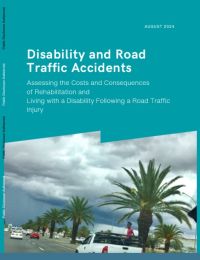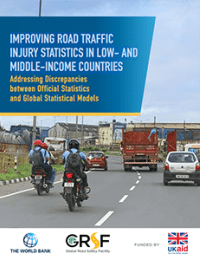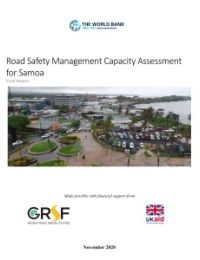Publications
1-3 of 3
-
-
Road Safety Data
Improving Road Traffic Injury Statistics in Low- and Middle-Income Countries
November 2023
- National decision-makers recognize the issue of underreporting but tend to dismiss higher estimates by global statistical models.
- Most countries use WHO GSRRS estimates.
- National health surveys and censuses in LMICs often contain relevant information, and minor modifications can greatly improve their usage for such measurements.
- Incorporating national health survey data into global statistical models can help resolve discrepancies and increase confidence in estimates.
- Integrating epidemiological data sources into global statistical models (GBD, GHE, GSRRS) to reduce discrepancies and increase confidence in their estimates.
- Including relevant questions in upcoming national data collections to facilitate epidemiological measurements of road traffic injuries.
- Encouraging local involvement in data production for better estimates.
- Enhancing coordination between the Institute for Health Metrics and Evaluation and the World Health Organization to improve estimates and reduce inconsistencies.
-
-
Utilize GRSF recommended methodology to gain a thorough understanding of road safety management capacity;
-
Assess institutional management arrangements as an important focus of the analysis of the road safety system in Samoa;
-
Consider the existing national road safety strategy—Samoa National Action Plan (SNAP) for the Decade of Action for Road Safety 2011-2020—and propose updates for the next period;
-
Provide capacity building on crash investigation and evidence-based road safety measures to ensure success and sustainability, with a focus on vulnerable road users such as females, children, and persons with disabilities; and,
-
Focus on crash data management, including providing hands on capacity building and crash analysis.
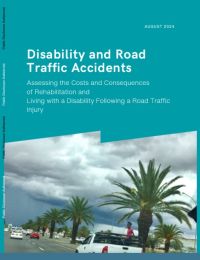
This GRSF-funded study explores the medical, economic, and social costs of road traffic accidents (RTAs), particularly focusing on individuals with permanent disabilities. According to the World Health Organization (WHO), RTAs are a global public health crisis, ranked as the 12th leading cause of death and the primary cause of mortality among children and young adults. While the UN's Decade of Action for Road Safety (2021–2030) aims to reduce RTA deaths, the study argues that more focus is needed on injuries and the long-term impact on those left disabled by RTAs.
Building on GRSF’s report Beyond The Numbers: Estimating the Disability Burden of Road Traffic Injuries (Mitra et al., 2023), this project examines data from Namibia and South Africa and interviews with experts to highlight the often-overlooked challenges faced by RTA-related disability survivors. These individuals encounter unique issues—such as brain injuries, psychological trauma, and sudden financial burdens—that require specific support mechanisms beyond general disability frameworks.
Economic losses from RTAs are substantial, with WHO estimating global costs up to $1.8 trillion annually. However, existing research focuses mainly on medical costs and productivity losses, neglecting broader social impacts. Data on the prevalence of permanent disabilities varies, underscoring the need for standardized research.
The study calls for integrating disability concerns into road safety policies, emphasizing that improved enforcement in low- and middle-income countries could prevent disabilities and reduce societal costs. Ultimately, it advocates for recognizing RTA-related disabilities as a critical issue within global health, disability policy, and development agendas.
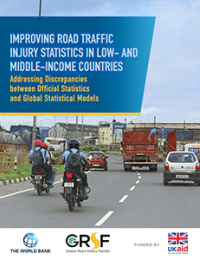
Road safety is a global health and economic issue that disproportionately affects low- and middle-income countries (LMICs). Precise data is crucial for understanding the full scope of the problem and developing effective interventions, but LMICs struggle to collect comprehensive data due to limited resources, underdeveloped health systems, and inconsistent data collection processes.
To overcome reporting gaps, three major global statistical models are utilized: The Institute for Health Metrics and Evaluation Global Burden of Disease (GBD) study, the World Health Organization (WHO) Global Status Reports on Road Safety (GSRRS), and WHO Global Health Estimates (GHE). However, discrepancies exist among these models and between them and official country statistics. They often estimate significantly higher road traffic fatalities and injuries than official LMIC statistics.
This GRSF study identifies the reasons behind statistical discrepancies and outlines strategies to strengthen modeling efforts. This involved qualitative research, a systematic review of national data availability, and four case studies in Brazil, Cambodia, Ethiopia, and Tanzania.
Key findings include:
Recommendations include:
To achieve the goal of the Second United Nations Decade of Action for Road Safety (reducing road traffic fatalities and injuries by 50% by 2030), substantial resources need to be allocated to road safety and accurate reporting and statistical estimates are required.
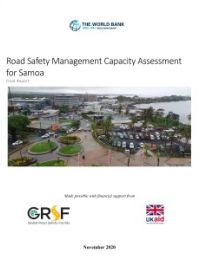
The Road Safety Management Capacity Assessment (RSMCA) is an activity within a broader Advisory Services and Analytics (ASA), which aims to gain a holistic and thorough understanding of the road safety management capacity of three selected Pacific Island Countries (PICs)—Samoa, the Solomon Islands and Vanuatu—in order to support their respective governments to develop national strategies and plans of action to improve road safety outcomes, with a focus on crash data management. The ASA will also support a pilot of the World Bank’s Data for Road Incident Visualization, Evaluation, and Reporting (DRIVER) road crash database in Samoa and provide hands on capacity building in crash analysis.
The ASA is being funded by a Global Road Safety Facility (GRSF) grant from the United Kingdom Agency for International Development (UK AID). The GRSF grant will help the Government of Samoa (GoS) to have a clear image of their road safety situation, risks and challenges, and further on to establish the basis for a national crash database. To ensure sustainability through capacity building and awareness-raising activities, knowledge will be shared with local stakeholders.
The key objectives of this ASA are as follows:
An auxiliary objective is to build capacity to use crash data to identify problems and implement road safety evidence-based measures in Samoa. Furthermore, given the negative impacts of severe weather events on road safety, which will be further exacerbated by climate change, the ASA will help to address the way that road safety is managed in the face of climate change, by training police officers to gain better skills in crash investigation.
The results from the DRIVER pilot in Samoa will be shared with counterparts in selected other PICs, with the aim of scaling up the system across the region. Only with accurate data can road safety be effectively managed and improved, and results measured. In support of this, as of October 2019, the World Bank’s Environmental and Social Framework (World Bank 2019) calls for road safety to be considered on all World Bank-funded projects.
The World Bank is also currently providing assistance to the road sector in Samoa through several projects, including the Samoa Climate Resilient Transport Project (SCRTP), which commenced in 2018. SCRTP will support the GoS to improve the climate resilience of the road network and provide key assistance required to contribute towards effectively managing climate resilient and safe road sector assets. One of the sub-components of SCRTP is dedicated to establishing and operationalizing a database for recording and analyzing road crash data.
The database will combine the existing siloed data, housed in different government agencies, into a single readily accessible platform under the Ministry of Work, Transport and Infrastructure (MWTI). The system will make use of DRIVER, to be piloted through this road safety ASA. SCRTP has other sub-components and activities focused on road safety, such as Road Safety Audits for project roads, a driver licensing training pilot focusing on women, and a road safety engineering technical assistance activity. This GRSF ASA will provide crucial data and insight for the successful delivery of the road safety program under SCRTP, plus other ongoing World Bank-financed projects.

